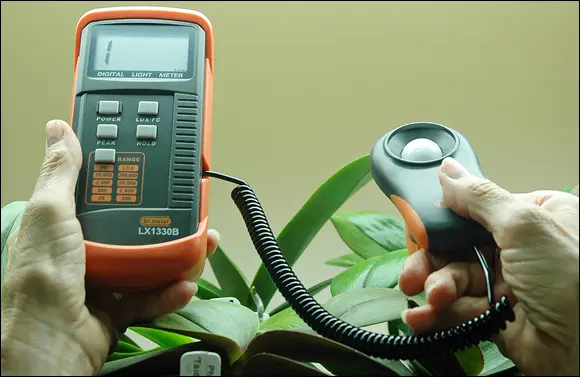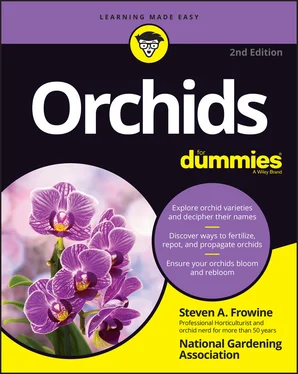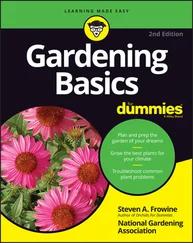Will you be growing the plants under artificial lights? Most light setups consist of multiple florescent high-output lamps and LEDs, and they can provide adequate illumination to most orchids. High-intensity-discharge lamps are capable of much more light output but can be expensive to operate and generate quite a bit of heat. For most folks the best option is going to be LED or various fluorescent bulb units. For much more details about lighting, see Chapter 5.
 How bright is your light? Figure 2-2 illustrates a simple yet effective and reasonably accurate method for determining the intensity of your light.
How bright is your light? Figure 2-2 illustrates a simple yet effective and reasonably accurate method for determining the intensity of your light.

© John Wiley & Sons, Inc.
FIGURE 2-2:The shadow test is a simple and reasonably accurate way to measure light intensity.
After you determine your light levels, turn to the following sections, which list orchids by the amount of light they need. Remember to keep in mind temperature (see the preceding section).
A more exact way to measure light is to purchase a handheld light meter (see Figure 2-3). You can purchase several modestly priced models, including free apps for your phone. I prefer the handheld models because they’re so easy to use.

© John Wiley & Sons, Inc.
FIGURE 2-3:An example of a handheld light meter.
The most common measure of light intensity is footcandles, which is equivalent to the light emitted by one candle one foot away. This is an old English measure that is still used today and what most light meters read.
Professional and very serious light gardeners use other more exact light measurements but, frankly, in most cases for home growers you don’t need to use them.
Bright light (5000 to 6000 footcandles)
The following orchids require a bright greenhouse, a very bright south-facing window, or four or more high-intensity fluorescent lamps, large banks of LEDs, or metal halide lamps (see Chapter 5):
Angraecum
Some varieties of Cymbidium
Some varieties of Dendrobium
Vanda
Medium light (2500 to 3000 footcandles)
The following orchids need a shaded greenhouse, a large east-facing window during the spring, summer, and early fall window or a four-tube florescent light fixture or LEDs of the same light output: (In the winter during shorter days and lower light the greenhouse needs to have some shade material removed, and plants can be moved to a brighter south window, or you can continue growing them under lights.)
Amesiella
Ascocenda
Ascocentrum
Ascofinetia
Brassavola
Brassia
Cattleya and hybrids
Some varieties of Cymbidium
Some varieties of Dendrobium
Epidendrum
Laelia
Leptotes
Masdevallia
Miltonia
Miltoniopsis
Neofinetia
Neostylis
Odontoglossum
Oncidium
Paphiopedilum (strap-leaf multiflorals)
Phragmipedium
Rhynchostylis
Zygopetalum
Low light (1500 to 2000 footcandles)
The following orchids do well with a low level of light, easily attainable with two to four fluorescent lights or LEDs with equivalent light intensity or on an east-facing windowsill:
Paphiopedilum (not including strap-leaf multiflorals)
Phalaenopsis
All orchid seedlings
 Many orchids can be grown at considerably higher light levels that are recommended if they’re gradually adapted to this higher light intensity and are in a well-ventilated area. Why would you even try this? Plants grown in higher light intensity tend to grow more compactly and can produce more flowers.
Many orchids can be grown at considerably higher light levels that are recommended if they’re gradually adapted to this higher light intensity and are in a well-ventilated area. Why would you even try this? Plants grown in higher light intensity tend to grow more compactly and can produce more flowers.
 Be sure to ask the grower about the temperature, light, and humidity requirements of the orchid you’re considering. Check out its ultimate size. Then match this information with what you know about your orchid growing area.
Be sure to ask the grower about the temperature, light, and humidity requirements of the orchid you’re considering. Check out its ultimate size. Then match this information with what you know about your orchid growing area.
Asking yourself these questions
In addition to considering temperature and light, you want to ask yourself the following questions:
Does the growing area have moist (humid) air, or is the air very dry? If it’s already humid (50 percent or greater), it’s perfect. If not, your orchids will be happier with moister air. See Chapter 5.
How much space do you have to grow orchids? If you have plenty of head room, you can grow some of the taller orchids, like cane dendrobiums and full-size cattleyas. If space is at a premium, search out very compact or miniature growers. Part 3gives you plenty of choices for plants of all sizes.
When do you want your orchids to bloom? Spring, summer, fall, or winter? In the evening or during the day? Armed with this information, you can pick those orchids that will be in bloom in the season and time of day of your choice.
Do you have air circulation in the growing area? Most homes have adequate air circulation, but if your orchids are going to be located in the basement or some other spot where the air is stagnant, you’ll want to consider a fan of some type to provide them with fresh air. See the ventilation section in Chapter 5for more information.
When you’re armed with this information, you’ll be better prepared to choose an orchid that will thrive.
Growing Tropical Orchids Outdoors
If you live in an area where you never experience freezing weather, you can enjoy growing your orchids year-round outdoors. Although some orchids can withstand and even prefer sun and can be grown directly in the ground, most of the orchids in this book are ones that prefer at least some shade and are usually grown in pots or on slabs of bark or wood. Hence, building an outdoor structure that has some type of benching and provides a diffused light of about 50 percent shade is a good idea (see Chapter 5).
Such a structure is also a buffer against high winds. Wooden lath or a saran shade cloth can provide the shade. Make sure you have a water faucet close to this structure so you can water the plants by hand or set up an automatic watering system. A water faucet is also handy in a dry hot climate, and you need to install a humidification system.
Knowing What to Look for in an Orchid
After you consider your environment, you’re ready to go shopping. You have an idea of which types of orchids will work best where you’ll be growing them, and now you just need to look at a few things such as the plant’s health and age. I fill you in on these factors in the following sections.
Picking out a healthy orchid plant is essential. Even in the best of circumstances, the orchid that you bring home will have to adapt to changes in its environment. A strong, robust plant has a much better chance of surviving this ordeal than a weak plant does.
Читать дальше

 How bright is your light? Figure 2-2 illustrates a simple yet effective and reasonably accurate method for determining the intensity of your light.
How bright is your light? Figure 2-2 illustrates a simple yet effective and reasonably accurate method for determining the intensity of your light.












